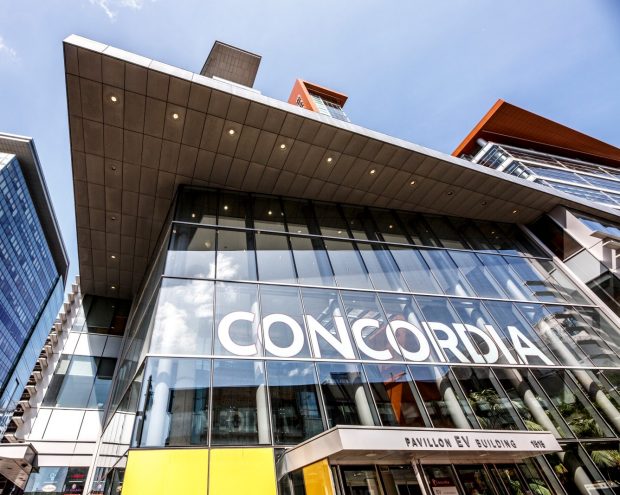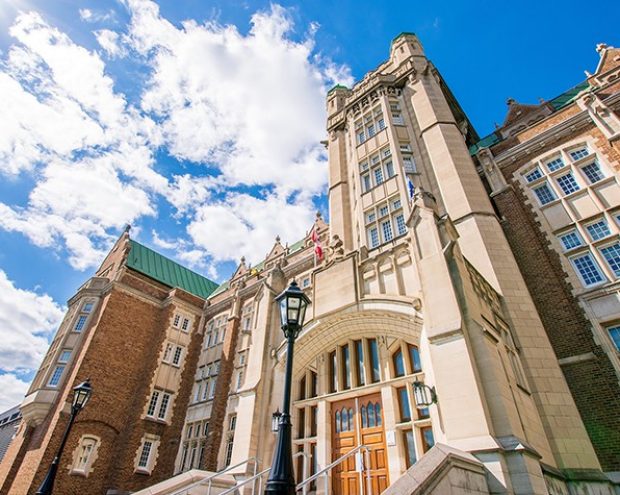Inclusive washrooms on campus
Concordia is committed to increasing the number of inclusive and accessible washrooms on campus. The goal is to reduce barriers related to both disability and gender, ensuring all members of our community can access these facilities.
Overview
Concordia is committed to reducing barriers and increasing access and inclusion for all those coming to its campuses. As part of its commitment to promoting equal access to education and an inclusive campus community, the university is increasing the number of inclusive and accessible washrooms on campus. The goal is to reduce disability and gender-based barriers encountered by community members.
At this time, the university's focus is on installing inclusive and accessible facilities in buildings that are frequented by the largest number of students, faculty and staff on both its campuses. Criteria such as the condition of infrastructure and other renovation projects are also considered during the prioritization process.
As a university committed to inclusion, Concordia will continue to ensure that there a variety of facilities available to the community, including individual washrooms. This approach takes into account the diversity of Concordia’s campus community and builds in options and solutions that meet a variety of needs.
Strategy
Concordia is first and foremost a group of diverse people. Their views are critical in understanding needs and aspirations. To honour this commitment to diversity, the university has taken a consultative approach to the development and deployment of inclusive and accessible washrooms across its campuses.
The aim of this strategy is to support an inclusive university culture that values the experiences of underrepresented groups and people with diverse access needs. Facilities Management continues to work closely with various internal partners, while the Equity Office plays a key role throughout the planning and development phases.
Together, the team analyzes, iterates and continuously consults the broader community to ensure ample opportunity for course corrections.
Design
New inclusive and accessible washrooms are designed with practicality and efficiency in mind. For instance, grooming areas are separate from the central hand-washing zones to prevent congestion.
Inclusive facilities also deliver a host of helpful amenities. Examples include:
- Floor-to-ceiling stalls for privacy and security
- Doorless, open entryways that encourage an efficient flow through the space
- Central washroom areas that connect to main hallways to ensure safe and effective circulation
- An adjustable step under the sink area
- Water fountains and water-bottle fillers
- Colour-coded locks to indicate when a stall is in use
- A free tampon dispenser
- Touch-free faucets and hand dryers above the sinks in certain washrooms
In addition, carefully considered design elements like customized lighting zones, a bright colour palette and a skylight effect above the washing area create a welcoming environment.
On top of meeting equity goals, particular attention has been paid to building enjoyable spaces that people feel comfortable using.
Timeline
2018
- Completed an analysis to convert washrooms on the main levels of the Engineering, Computer Science and Visual Arts Integrated Complex (EV), J.W. McConnell (LB) Building and Henry F. Hall (H) Building into inclusive and accessible washrooms.
- Conducted consultations in partnership with Property Management and Campus Safety and Prevention Services, under the oversight of the Office of the Provost and Vice-President, Academic and the Office of the Vice-President, Services and Sustainability.
2019
- Installed the university’s largest inclusive and accessible washroom facility at the time of its opening in the Learning Square (LS).
- Passed a motion to renovate washrooms that require base building restoration on alternating floors of the Hall Building to inclusive and accessible washrooms. This decision included a commitment to make individuals washrooms available on floors with inclusive and accessible washrooms.
- Launched the Hall 6 transformation as a pilot project for installing the building's first inclusive and accessible washrooms.
- Submitted an application to the Régie du bâtiment du Québec to modify sanitary installations in the Hall Building.
2020
- Administered surveys and consultations with Concordia students, faculty and staff in partnership with SOM, a research firm specializing in data collection, data analysis and data visualization.
2021
- Continued to administer surveys and consultations in partnership with SOM.
- Directed accessibility audits of the Sir George Williams and Loyola campuses and led a circulation study of both campuses.
- Completed the inclusive and accessible washrooms project in the basement of the Faubourg (FB) Building.
- In collaboration with HCMA, an architecture and design firm, began work on a five-year accessibility and inclusivity plan that will outline steps for Concordia to take to make progress toward its vision for accessible and inclusive facilities. The plan will be informed by expert recommendations, surveys and feedback on inclusive and accessible washrooms.
2022
- Confirmed that all newly renovated public washrooms will be inclusive and accessible, everywhere possible. This decision was made by Concordia's senior management, in collaboration with the Equity Office, following consultations and surveys by SOM.
- Established that all floors of the Hall Building will include inclusive and accessible washrooms — not just those on alternating floors.
- Based on the continued work of the five-year accessibility action plan, resolved that physical adaptation — not just signage — is paramount to the successful transformation of inclusive and accessible washrooms.
- Oversaw an online survey, a vision workshop and a series of consultation workshops focused on key aspects of the physical environment on campus.
- Delivered the Hall Building’s second inclusive and accessible washroom on the fourth floor as part of the Hall 4 renovation project.
2023
- Opened the first inclusive and accessible washrooms at the Loyola Campus on the fifth floor of the Administration (AD) Building.
- Renovated washrooms on the first floor of the Communications and Journalism (CJ) Building that go beyond code requirements for accessible washrooms. The improvements were delivered as part of the Critical Disabilities Lab Project.
- Opened new inclusive and accessible washrooms on the main levels of the LB and EV buildings.
2024
- Carried out a survey to measure user satisfaction with the new inclusive and accessible washrooms on the main levels of the LB and EV buildings.
- Initiated work to renovate additional existing washrooms into inclusive and accessible washrooms in the Hall Building.
- Phase 1: floors 1, 3 and 7 (fall 2024)
- Phase 2: first floor basement (winter 2025)
- Phase 3: upper floors (2026 and beyond)
Future projects
- Construct inclusive and accessible washrooms in the basement of the Faubourg Ste-Catherine (FG) Building as part of a larger project to renovate existing classrooms.
Key findings
A diversity of viewpoints and a wide range of insights have been expressed throughout various consultation sessions. The following are key findings of what has been heard regarding existing and planned washrooms on campus and visions for the future.
Existing washrooms on campus
Concerns around:
- The insufficient concentration and lack of gender inclusive washrooms, especially at the Loyola Campus.
- The accessibility of single-stall washrooms.
- The requirement to use a personal key card to access washrooms.
- The need to choose classes based on proximity to gender inclusive washrooms.
- Cleanliness, privacy and safety of washroom spaces, particularly after hours.
- Comfort level in multi-stall gender inclusive washrooms. Preference for single-stall gender inclusive washrooms.
Future of washrooms on campus
Concerns around:
- Design solutions being better suited for newer and/or larger buildings, rather than some of the small, inaccessible buildings on campus and the extent of other barriers that exist.
- Design solutions requiring a large amount of square footage that would need to be taken from other existing spaces.
- Options for updating when the visibility and openness of existing washroom spaces is poor.
- Options for updating washrooms in spaces or buildings that are rented and not owned by Concordia.
- The security of washroom spaces, especially after hours, and a need to go above and beyond just installing cameras.
Visions for the future of washrooms on campus
Support for:
- Creating welcoming and respectful spaces.
- Creating private, safe, clean spaces where users can feel relaxed, secure and not isolated.
- Incorporating multiple accessible stalls within a multi-stall washroom.
- Accessible and inclusive washroom signage.
- Signage and interactive maps that identify gender inclusive washroom locations.
- The integration of quiet, touch-free fixtures.
- The integration of adequate lighting (well-lit spaces) and proper ventilation.
- Integrating inclusive décor, including colours, graphics and images and removal of cis- and hetero-normative ads and images.
See also
- For more information on inclusivity resources and support for students, visit the Centre for Gender Advocacy.
- For student accommodations and support, visit the Access Centre for Students with Disabilities (ACSD).
- For support on equity issues, visit the Equity Office.



